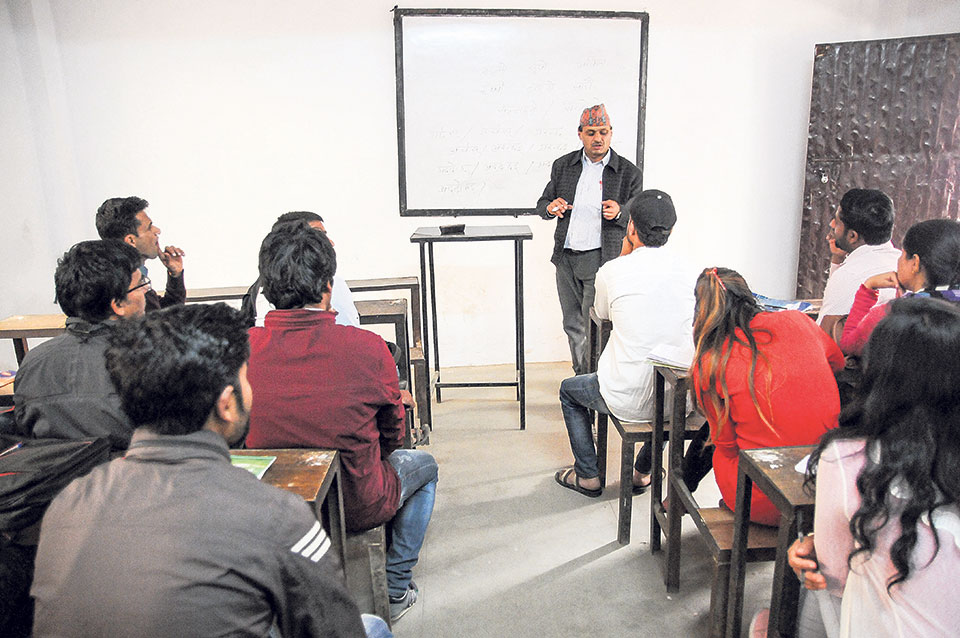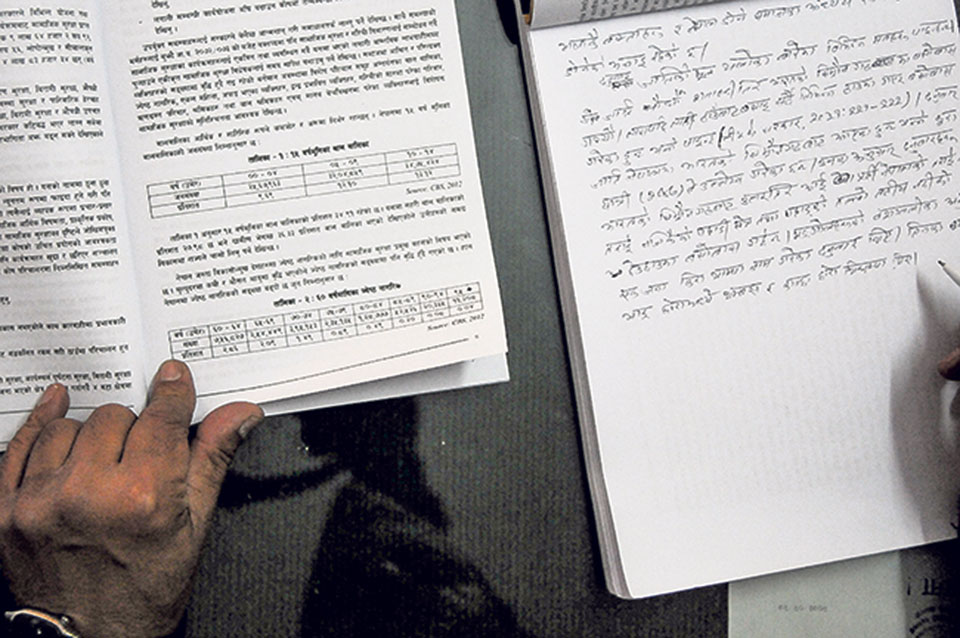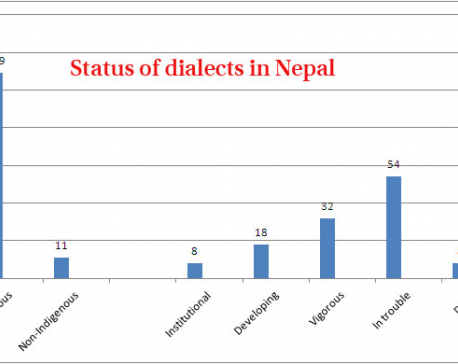
OR
Cover Story

Dialects make up a tiny portion of the Nepali classes at Ratna Rajya Laxmi Campus. But even the one class that tends to be dedicated to the topic makes the professor, Dr Yagyneswor Niroula, excited. This is partly because he almost always has all the examples required to explain the concept to his class in his class itself.
At one point, there were five different students: One from Jhapa, another from Surkhet, two from Syangjha, and one from Humla. As an example, Niroula asked the student from Jhapa what he calls the traditional kitchen tool used to sort rice at home. “Nanglo,” was the answer he got. He then pointed to the students from Syangjha, while one agreed with his friend’s answer, the other insisted that it was called, “Supo.” The remaining two students from Surkhet and Humla agreed with the latter answer as well. And just like that more students in the class started throwing in names used to describe the same kitchen tool at their homes.
Were they speaking a different language? No, it was, indeed, all Nepali but in different dialects. This, says Niroula, is the charm of language. “Each dialect carries its community’s identity with it. The Nepali I speak can’t relay the culture of Surkhet or Humla. That’s what makes dialects so interesting and, in my opinion, incredibly important.”
As it happens, it is with Niroula’s citing that linguists claim our Nepali language to have 12 dialects all together. The first ever proper survey on the matter takes us back to 1994. Niroula’s professor, Dr Madhav Prasad Pokhreal remembers assigning this very project to Niroula and four other students in their master’s year.
About his intention behind assigning the survey, Pokhreal says, “Up until then, we only had Bal Krishna Pokhreal’s work which initially stated that our Nepali language had three dialects. Later he revised the number to five. I really wanted to investigate this theory.”
So he put his students to work. Pokhreal shares that each of the five students were asked to research on different aspects. He instructed one to compare and survey the differences between Nepali pronouns, another to do the same with counting words, Nepali verbs, pronunciations and basic Nepali vocabulary. Cleverly enough, they also devised an efficient way to collect samples without leaving the capital. Pokhreal decided to carry the survey out at Kirtipur College and Tahachal Campus.
“As always, we could find students and trainees from around our country there and we picked ones that had just arrived from their hometowns,” says Pokhreal.
Niroula too still remembers the assignment. He specifically remembers interviewing the students and painstakingly listing down all the words because there were no tape recorders at the time. But this particular survey project also proved to be significant because he continued the work into his PhD and still goes out for research whenever time and finances allow him to.
He believes the time put into it to be worth it because, as far as he is concerned, we all speak in dialects. “It’s just that time turns it into a language,” he says.
To prove his point, he quotes a 13th century Nepali phrase: Hamra ali atali atal karya karachau. It’s obvious that today, only a Nepali linguist would understand or recognize that phrase, yet, he points that it is Nepali.
Similarly, our language took a different turn when the reign of Prithivi Narayan Shah started. But Niroula is certain that the inscriptions and letters of the era too will be incomprehensible for Nepalis today. “Indeed a language can’t rule without power,” agrees Pokhreal, “When it is powerless, it becomes a dialect.”
If we were to turn the pages of history, we can find evidence that proves that the dialect accepted as the standard Nepali today largely came from Gorkha once Prithivi Narayan Shah had taken over. With power the Eastern region dialect became more widely accepted. Pokhreal even informs us that, before Shah, they are important transcripts and letters written in what is today considered Jumeli dialect because, with the Khas Rajya, they were once in power.
But even away from the historical aspects and the political stage, differences in how Nepalis speak Nepali are evident on a daily basis as well. You can take an example with a simple phrase like, ‘garne ho’. People from Darchula have been known to say it as ‘garnya ho’, those from Bajhyang: ‘garnyachu.’
If somebody from Kathmandu was to ask, Ko cha?, those from Kaski usually say, “Ko Kha?” Similarly, “yo cha” in Surkhet becomes “aie chyo.”Another common Nepali word like ‘garchas’ has different variations throughout the country. From ‘garchai’, ‘gadchai’, ‘gardohai’ to ‘gadahai’, all have the same meaning and are still Nepali.
Now the reasons behind the emergence of dialects within the Nepali language, according to experts like Pokhreal and Niroula, are geographical and, again, political. Even back in the 90s, Pokhreal speaks of how they had noted that those from the Karnali region had the most distinct dialects whereas large areas from the east only had subtle differences in how they spoke Nepali. This, he explains, had a lot to do with geography and transport accessibility in the region.
“Large forests, big mountains, and dangerous rivers have been known to keep communities apart,” he says, “And in the process, they develop their own dialects.”
To that, Niroula adds that particularly in Nepal’s case, political and historical influences can also be noted. He refers back to the time when our country was divided into multiple kingdoms and where the kings forbade their citizens’ to venture into other’s territories or risk battles. According to Niroula, such strict restrictions only fuelled the differences.
However, as somebody who studies dialects, Niroula doesn’t want people to exaggerate these dissimilarities. He confesses to being disgruntled with this particular practice that has taken over our country of late. “Now the consensus has labeled Jumeli, Baitadi, Doti and such as different languages. I don’t know what the conspiracy behind this is because my research states they are Nepali,” he says.
Among other research, one that he cites with confidence is the intelligibility test, the Recorded Test Testing (RTT). As part of his PhD, he traveled to places like Jumla, Darchula, Doti, Rukum and recorded the locals there. As per the system, he had asked the locals to retell shorts incidents in their lives and then edited each recording into 10 parts and developed questionnaires from them.
Later, he tested people from Darchula with recordings from Jumla and vice versa and likewise coordinated tests among locals from Doti and Rukum as well. The results showed that the participants understood more than 60 percent of the content. Globally, social linguists consider this to be proof that they are all speaking Nepali. It’s just that they have different dialects.
Niroula warns that such misunderstandings about our own language can have grave social impact. The effort should be put in uniting people with different dialects under Nepali, not building up barriers.
His own class proves that it isn’t a difficult task. We just have to accept the diversity as our own. Discussions that start from exploring different Nepali words that represent the same thing, regardless of them being as mundane as a nanglo, can help us appreciate the richness of our language.
priyankagurungg@gmail.com

You May Like This

Decoding RPP split
Much to the disappointment of its cadres and supporters across the country, the Rastriya Prajatantra Party (RPP) witnessed a vertical... Read More...

Local dialects on verge of extinction in lack of utility
KATHMANDU, Aug 12: At a time schools and colleges are happy teaching foreign languages, fueling massive brain drain from the... Read More...

Lacking utility, local dialects on verge of extinction
KATHMANDU, Aug 3: At a time when universities, colleges and private education institutes are vigorously promoting foreign languages, no one... Read More...




Just In
- MoHP cautions docs working in govt hospitals not to work in private ones
- Over 400,000 tourists visited Mustang by road last year
- 19 hydropower projects to be showcased at investment summit
- Global oil and gold prices surge as Israel retaliates against Iran
- Sajha Yatayat cancels CEO appointment process for lack of candidates
- Govt padlocks Nepal Scouts’ property illegally occupied by NC lawmaker Deepak Khadka
- FWEAN meets with President Paudel to solicit support for women entrepreneurship
- Koshi provincial assembly passes resolution motion calling for special session by majority votes







_20220508065243.jpg)






Leave A Comment